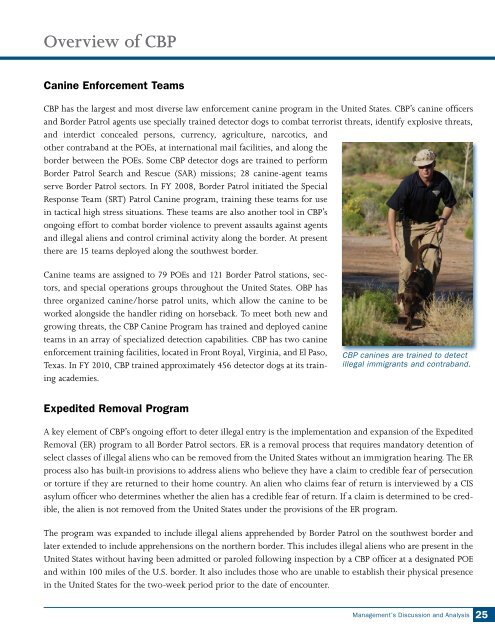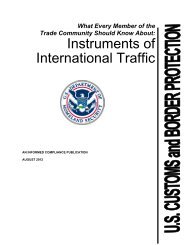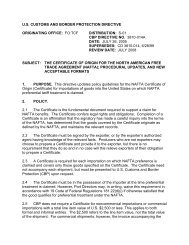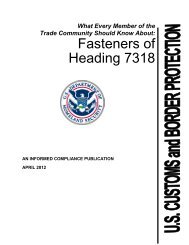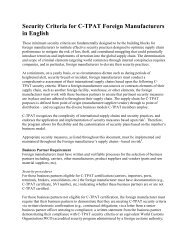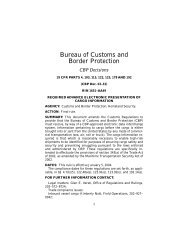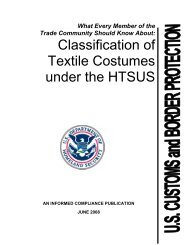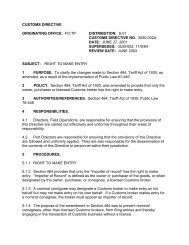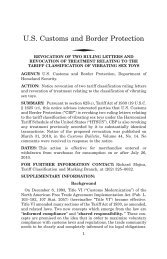Fiscal Year 2010 CBP Annual Financial Report - CBP.gov
Fiscal Year 2010 CBP Annual Financial Report - CBP.gov
Fiscal Year 2010 CBP Annual Financial Report - CBP.gov
Create successful ePaper yourself
Turn your PDF publications into a flip-book with our unique Google optimized e-Paper software.
Overview of <strong>CBP</strong><br />
Canine Enforcement Teams<br />
<strong>CBP</strong> has the largest and most diverse law enforcement canine program in the United States. <strong>CBP</strong>’s canine officers<br />
and Border Patrol agents use specially trained detector dogs to combat terrorist threats, identify explosive threats,<br />
and interdict concealed persons, currency, agriculture, narcotics, and<br />
other contraband at the POEs, at international mail facilities, and along the<br />
border between the POEs. Some <strong>CBP</strong> detector dogs are trained to perform<br />
Border Patrol Search and Rescue (SAR) missions; 28 canine-agent teams<br />
serve Border Patrol sectors. In FY 2008, Border Patrol initiated the Special<br />
Response Team (SRT) Patrol Canine program, training these teams for use<br />
in tactical high stress situations. These teams are also another tool in <strong>CBP</strong>’s<br />
ongoing effort to combat border violence to prevent assaults against agents<br />
and illegal aliens and control criminal activity along the border. At present<br />
there are 15 teams deployed along the southwest border.<br />
Canine teams are assigned to 79 POEs and 121 Border Patrol stations, sectors,<br />
and special operations groups throughout the United States. OBP has<br />
three organized canine/horse patrol units, which allow the canine to be<br />
worked alongside the handler riding on horseback. To meet both new and<br />
growing threats, the <strong>CBP</strong> Canine Program has trained and deployed canine<br />
teams in an array of specialized detection capabilities. <strong>CBP</strong> has two canine<br />
enforcement training facilities, located in Front Royal, Virginia, and El Paso,<br />
Texas. In FY <strong>2010</strong>, <strong>CBP</strong> trained approximately 456 detector dogs at its training<br />
academies.<br />
Expedited Removal Program<br />
<strong>CBP</strong> canines are trained to detect<br />
illegal immigrants and contraband.<br />
A key element of <strong>CBP</strong>’s ongoing effort to deter illegal entry is the implementation and expansion of the Expedited<br />
Removal (ER) program to all Border Patrol sectors. ER is a removal process that requires mandatory detention of<br />
select classes of illegal aliens who can be removed from the United States without an immigration hearing. The ER<br />
process also has built-in provisions to address aliens who believe they have a claim to credible fear of persecution<br />
or torture if they are returned to their home country. An alien who claims fear of return is interviewed by a CIS<br />
asylum officer who determines whether the alien has a credible fear of return. If a claim is determined to be credible,<br />
the alien is not removed from the United States under the provisions of the ER program.<br />
The program was expanded to include illegal aliens apprehended by Border Patrol on the southwest border and<br />
later extended to include apprehensions on the northern border. This includes illegal aliens who are present in the<br />
United States without having been admitted or paroled following inspection by a <strong>CBP</strong> officer at a designated POE<br />
and within 100 miles of the U.S. border. It also includes those who are unable to establish their physical presence<br />
in the United States for the two-week period prior to the date of encounter.<br />
Management’s Discussion and Analysis<br />
25


